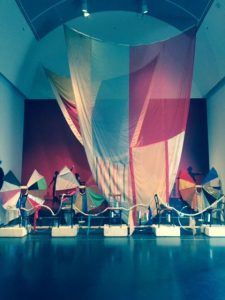‘Merce Cunningham: Common Time,’ now at the Museum of Contemporary Art Chicago, is an excellent example of how the arts can fall into neatly separated compartments and yet be integrated into an astonishingly workable whole.

Videos zoom in on Cunningham’s innovative choreography so that viewers understand that this famed dancer’s concentration on body movements revolutionized modern dance.
But although the title ‘Common Time’ may seem unusual for an exhibit that is a retrospective of a brilliant dancer and choreographer, it quite succinctly sums up how Cunningham pulled in art and music for his company’s performances.
A multi-media exhibition, visitors will see galleries of props, costumes and sets by artists such as Robert Rauschenberg, Jasper Johns, Frank Stella, Andy Warhol, Naum June Paik and Robert Morris.
There are also installations by Ernesto Neto and Charles Atlas and listening stations for music by Cunningham life partner and collaborator John Cage, Morton Feldman, David Behrman David Tudor, Takehisa Kosugi and Pauline Oliveros.
The surprise is that when Cunningham chose these artists to come up with something for a dance composition, he didn’t give them a theme. They were on their own.
“Merce selected the artists, reviewed their portfolios and knew of their work. He definitely did not instruct artists – costume design, décor, on what to do,” said ‘Common’s’ MCA Curator Lynne Warren. “It was often frustrating for the artists.”
“Sometimes they would have a title, where there was a title, but not always,” Warren said. “He might say how long a dance was or how many roles or how many dancers.”

She added, “What the audience experiences, what they see, is a presentation that is multi-disciplinary, if not strictly coordinated. Merce’s concept was equal parts dance, props, music. He would make it all work.”
A Cunningham quote used in the exhibit explains his multidisciplinary approach as an “underlying principle that music and dance and art could be separate entities independent and interdependent, sharing a common time.”
Warren pointed out that Cunningham’s dances did not fit popular concepts of themed presentations.
“Merce’s dances did not tell a story. They were an articulation of body movement,” she said.
She noted that people not in the dance world likely did not know of Cunningham’s work model.
“Merce introduced innovative concepts, radical enough to affect the world of dance and visual arts. They are a model for what is happening today,” Warren said.
Details: Organized by Minneapolis’ Walker Art Center and appearing simultaneously there and at the Museum of Contemporary Art Chicago, the exhibition is at the MCA, 220 E Chicago Ave Chicago IL 60611 now through April 30, 2017. For admission and other information call (312) 280-2660 and visit MCA.
